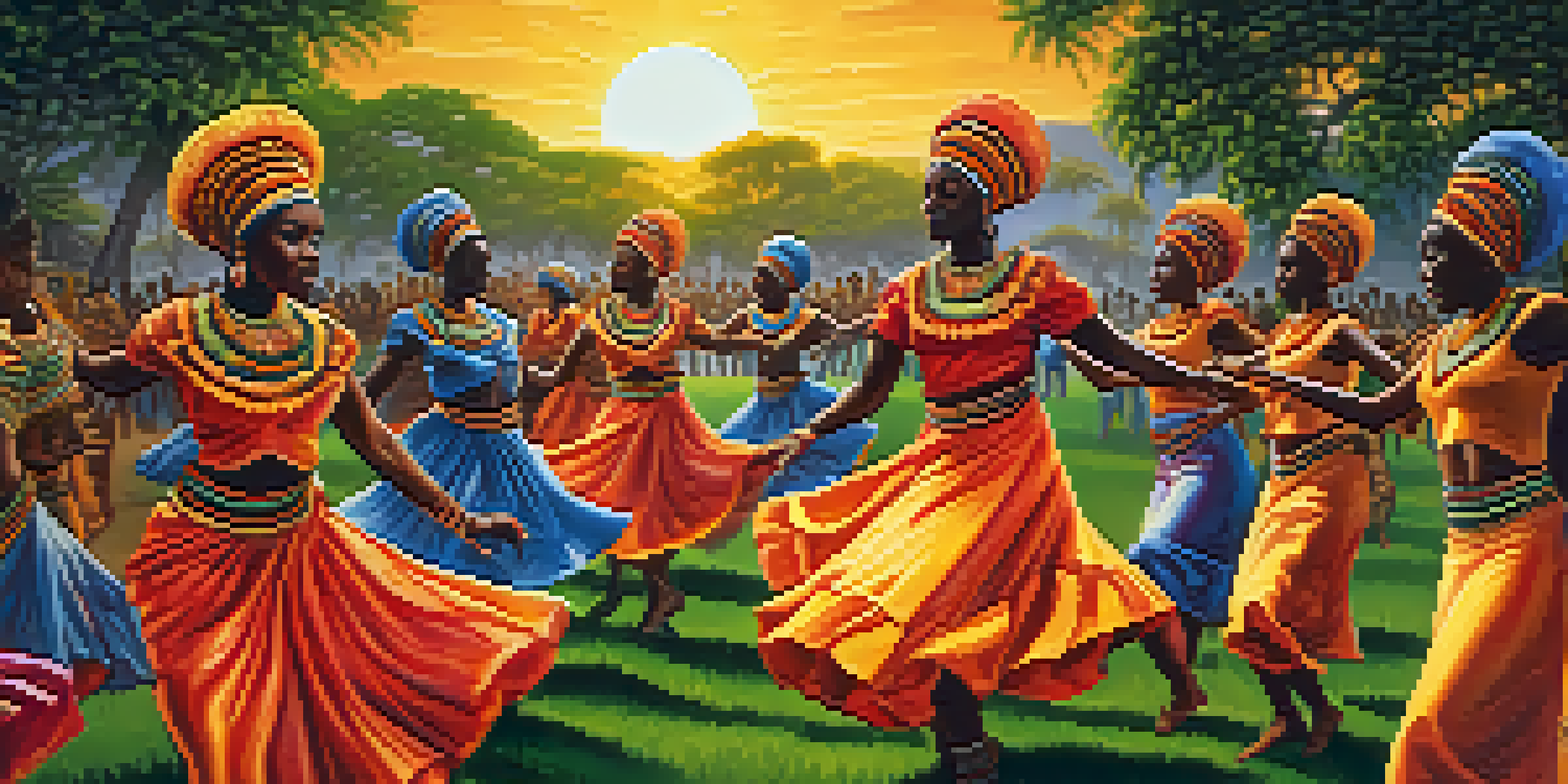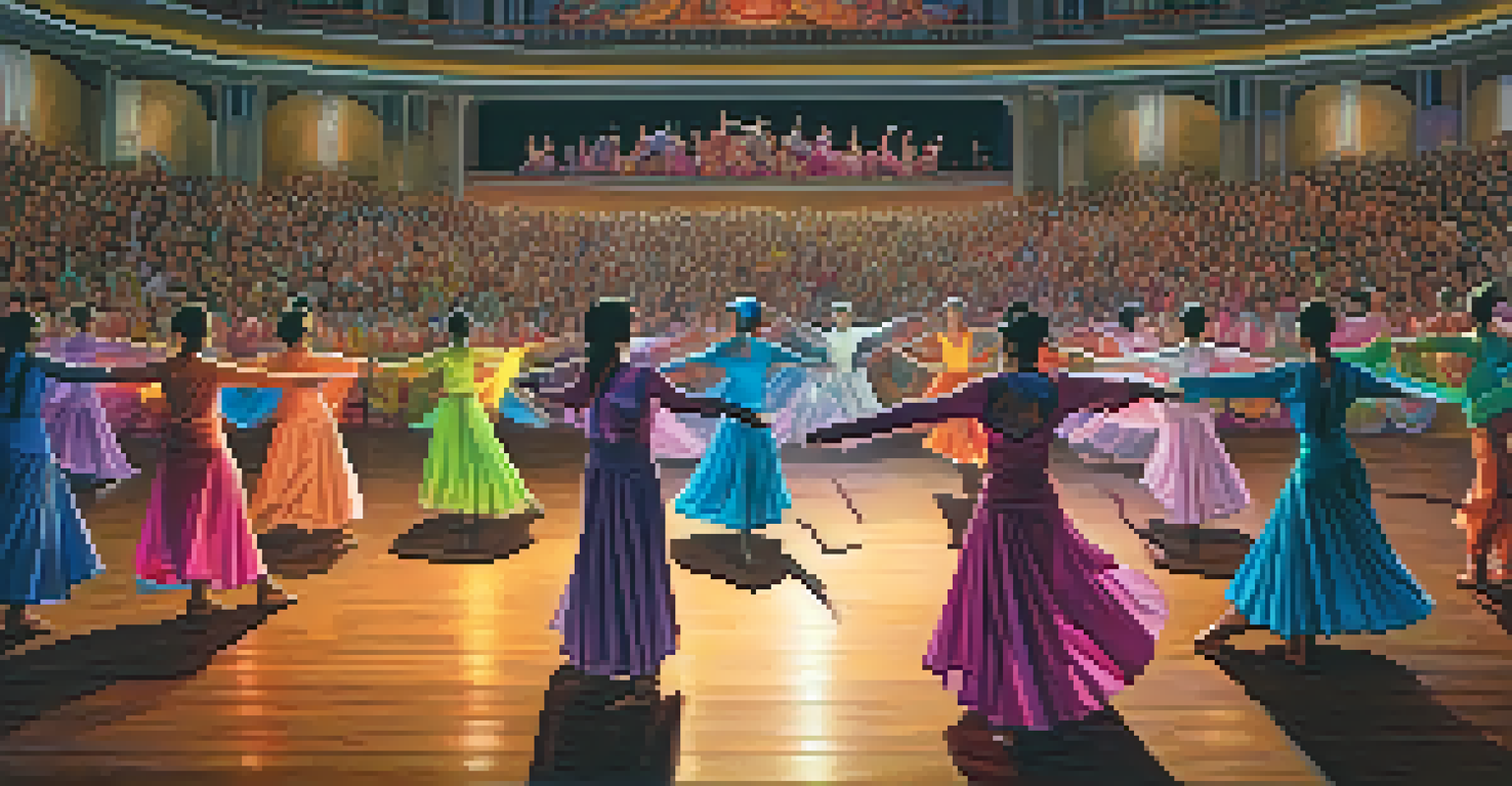The Influence of Global Cultures on Dance Evolution

Dance as a Reflection of Cultural Identity
Dance is often a mirror reflecting the cultural identity of a community. Through movements, rhythms, and styles, dancers express their traditions, beliefs, and stories. For instance, traditional African dances often celebrate life events and communal values, showcasing the vibrant spirit of the culture.
Dance is the hidden language of the soul.
As cultures evolve and interact, so do their dance forms. The blending of different cultural influences can create new styles, as seen in the fusion of African rhythms with European ballet techniques. This melding not only enriches the art form but also fosters a greater understanding of diverse cultures.
Related Resource
Ultimately, dance serves as a powerful tool for cultural preservation and communication. By participating in or observing various dance forms, people can gain insights into the history and values of different communities, bridging gaps between cultures through shared movement.
Historical Context: Dance Through the Ages
To understand the evolution of dance, we must look at its historical context. Dance has been a part of human expression since ancient times, often tied to rituals, celebrations, and storytelling. For example, in ancient Greece, dance was integral to religious ceremonies and theatrical performances, showcasing its importance in society.

As societies progressed, dance transformed alongside them, adapting to changes in culture and technology. The Renaissance period, for instance, saw the rise of court dances that reflected the social hierarchies of the time. These shifts illustrate how dance evolves in tandem with the cultural landscape.
Dance Reflects Cultural Identity
Dance serves as a powerful expression of cultural identity, showcasing traditions and stories through movement.
Today, dance continues to evolve, influenced by globalization and technological advancements. Social media platforms allow for the rapid spread of dance trends, making it easier for diverse styles to reach a broader audience and inspire new generations of dancers.
The Role of Migration in Dance Evolution
Migration has always played a significant role in shaping dance forms worldwide. When people move from one region to another, they bring their cultural practices, including dance. This exchange can lead to the creation of hybrid styles, such as the salsa, which combines African, Caribbean, and Latin influences.
The dance of life is the dance of diversity.
As communities intermingle, they share their stories, traditions, and dance techniques, leading to rich, diverse expressions. For example, the influence of African dance on American social dance forms, like jazz and hip-hop, showcases how migration can create vibrant new art forms that celebrate cultural diversity.
Related Resource
This ongoing evolution is a testament to the resilience and adaptability of dance. It reflects humanity's ability to connect and collaborate, reminding us that while we may come from different backgrounds, our shared love for movement unites us.
Cultural Exchange: The Dance of Collaboration
Cultural exchange is a vital component of dance evolution, fostering collaboration between different artistic traditions. Dance festivals and workshops often bring together artists from various backgrounds, allowing them to share techniques and styles. This exchange not only enriches the dancers' skills but also deepens their understanding of global perspectives.
For instance, the influence of Bollywood dance on Western pop culture has resulted in a unique blend of styles, showcasing how cultural exchange can lead to innovation. Choreographers and dancers draw inspiration from various sources, creating dynamic performances that resonate with diverse audiences.
Migration Shapes Dance Forms
Migration plays a critical role in the evolution of dance, leading to the creation of hybrid styles that celebrate cultural diversity.
Through collaboration, dance can transcend cultural barriers and create a sense of community. By embracing different styles and techniques, dancers contribute to a richer, more inclusive artistic landscape, celebrating the beauty of diversity in movement.
Dance Styles: A Global Tapestry of Movement
The world of dance is a rich tapestry woven from countless styles, each with its unique history and significance. From the passionate flamenco of Spain to the graceful ballet of France, each style tells a story rooted in its cultural context. These diverse forms not only highlight the creativity of different cultures but also their shared human experiences.
As dance styles evolve, they often incorporate elements from other traditions, creating new forms that reflect a blend of influences. For example, contemporary dance frequently draws inspiration from traditional folk dances, resulting in innovative performances that honor their origins while pushing artistic boundaries.
Related Resource
This global tapestry of movement showcases the interconnectedness of cultures. By exploring and embracing various dance styles, we can appreciate the richness of global diversity and recognize how these forms of expression resonate with universal themes of love, struggle, and celebration.
Technology's Impact on Dance Evolution
In today's digital age, technology plays a crucial role in the evolution of dance. With platforms like YouTube and TikTok, dancers can share their work with a global audience, gaining inspiration from diverse styles and trends. This accessibility has led to the rapid spread of new dance forms and fusions, connecting artists from all corners of the globe.
Moreover, technology has transformed how we learn and create dance. Online classes and tutorials make it easier for aspiring dancers to explore various styles, breaking geographical barriers. This democratization of dance education allows for a richer exchange of ideas and techniques across cultures.
Technology Transforms Dance
The rise of technology has revolutionized dance by enabling global sharing and learning, fostering new forms and collaborations.
As technology continues to advance, it will undoubtedly shape the future of dance in ways we can't yet imagine. The fusion of traditional forms with cutting-edge technology promises to create new experiences and expressions, reflecting the ongoing evolution of this dynamic art form.
The Future of Dance: Embracing Diversity
Looking ahead, the future of dance is bright, particularly as we continue to embrace diversity and inclusivity. As more cultures share their traditions and stories through dance, we can expect to see even more innovative forms emerge. This evolution not only celebrates individual cultural identities but also fosters a sense of unity among dancers worldwide.
Furthermore, as society becomes increasingly aware of the importance of representation, we can anticipate a greater emphasis on authentic storytelling within dance. By highlighting underrepresented voices and experiences, the dance community can create a more equitable space for all artists to thrive.

Ultimately, the evolution of dance is an ongoing journey that reflects the richness of human experience. As we celebrate our differences and learn from one another, dance will continue to evolve, offering a powerful medium for connection and expression across cultures.